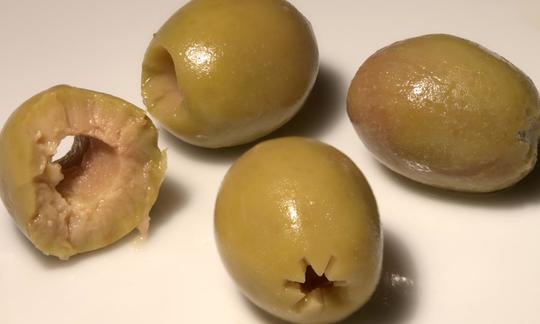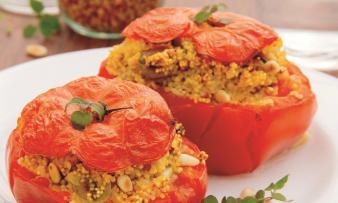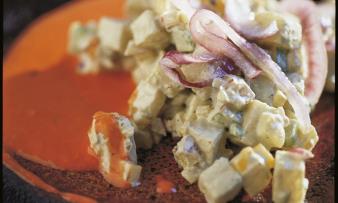Table of contents
Green olives ( Olea europaea ) taste very bitter when raw, which is why they are usually "washed". If preserved in brine, they are edible after about a month. Prefer organic quality.
Use in the kitchen
Green olives are a stone fruit and a popular part of Mediterranean cuisine. They are used either as table olives in the form of antipasti or as side dishes. From an economic point of view, pressing green olives to make olive oil is of the greatest importance.
There are three stages of ripeness: Green olives are unripe, hard and very bitter in taste. During this ripening phase, olives range from green to green-yellow.
As they ripen, they turn red-brown; when processed, they appear pink, rosé or brown; some say red (red olives). They are harvested before they are fully ripe. In English, they are called turning-color olives. 17
Black olives stay on the tree longer and are less bitter, with a sweet taste and softer flesh. They are also easier to pit. The aroma of black olives can be described as mild to intense, with a spicy to nutty note. The ripe fruits are reddish-black to violet-black, dark violet, greenish-black or appear in a deep chestnut brown. 17
There are also unripe, black olives. These olives are colored by the food industry. Iron-II gluconate or iron-II lactate is used to blacken them, which changes the taste and extends the shelf life. 17
All olives are inedible raw and must be soaked several times to wash out the bitter substances. Green olives are often preserved in brine or olive oil and can be flavored with various herbs or spices. Popular fillings for pitted green olives are: almonds, garlic, peppers, capers, lemon peel, cheese or anchovies. Green olives are good as a side dish or in salads (including potato salad ) and in the filling of stuffed peppers or tomatoes, but they can also be found in Mediterranean dishes such as pasta, pizza and stews.
Olive paste, known as tapenade, is a traditional French paste that contains black or green olives, capers, anchovies, garlic and olive oil . It is extremely popular as a spread on bread, a dip for vegetable sticks or crackers and as an ingredient in sauces and dressings. Olives are also a must in a refreshing Greek salad with tomatoes, cucumbers, peppers and onions, complemented with fresh flat-leaf parsley and tofu as a vegan alternative.
If you value raw food quality, make sure when purchasing olives that they are not pasteurized or otherwise heated.
Making your own green olives
You can harvest olives straight from the tree and treat them yourself to make them edible and to increase their shelf life. It is important that the olives are free of blemishes. The process involves three steps: pre-treatment, soaking and pickling.
There are several methods for reducing the bitterness of green olives. The quickest method is to crush the olives, known as tsakistes. Black olives are often too ripe for this and there is a risk of splashing on clothing. Alternatively, the olives can be cut lengthways in three places, a method called charaktes, or they can be placed directly in the brine, known as kolimvites or "floating olives". The latter preserves the integrity of the olives but takes the longest to lose the bitter taste. In industry, mechanical pitting is done by punching. 3
The crushed, cut or punched olives are soaked in a closed container with fresh water to remove the oleuropein, which is responsible for the bitterness. The water must be changed daily for about 10 days. 3
Finally, drain the olives and place them in a container with brine that contains about 7 to 10% salt per liter of water and a teaspoon of citric acid or about 10% wine vinegar. To ensure a homogeneous mixture, the brine must be boiled beforehand. The amount of brine should be roughly the same as the amount of olives. For additional flavor, you can add red wine vinegar, garlic, onions and herbs. However, they are not ready to eat straight away: bruised olives should mature in this brine for about four weeks, cut olives for six weeks and intact olives for two months. Covered with a layer of vegetable oil and tightly sealed, the treated olives will keep for at least six months at room temperature or a year in the refrigerator. 3
Vegan recipe for olive tapenade
Olive tapenade can be made with both green and black olives . Green olives give the tapenade a slightly bitter note, while black olives offer a sweeter flavor.
Ingredients (for 4 people): 100 g pitted green olives, 100 g pitted black olives, 15 g capers, 1 clove of garlic, juice of ½ lime, 1 teaspoon Dijon mustard, 1 tablespoon olive oil, 1 sprig of rosemary, 1 pinch of salt andblack pepper .
Preparation: Drain the olives and capers, chop finely and put them in a bowl. Finely chop the garlic, halve the lime and squeeze it, then add to the olive mix. Add the mustard, oil and the picked and finely chopped rosemary. Mix everything well and season with salt and pepper. Leave the mixture in the fridge for 30 minutes. The finished tapenade can be served as a dip with baguette, crackers or baked potatoes. The Mediterranean spread will stay fresh for up to four weeks in an airtight container.
Vegan recipes with pitted green olives (raw) can be found under the note: " Recipes that have the most of this ingredient ".
| Not only vegans or vegetarians should read this: Vegans often eat unhealthily. Avoidable nutritional errors . |
Shopping - Storage
You can find preserved green olives, packed in glass or plastic, in supermarkets such as Coop, Migros, Denner, Volg, Spar, Aldi, Lidl, Rewe, Edeka, Hofer or Billa . Olives that are as natural as possible are available online or in health food stores, drugstores or organic supermarkets (e.g. Denn's Biomarkt or Alnatura ). Pickled olives (with or without stones) usually have a higher salt content and are almost always pasteurized, i.e. no longer raw. Dried olives, especially black olives, are occasionally available raw and without added salt.
Raw green olives, for preserving yourself, are more likely to be found at farmers' markets or in specialised delicatessens for Mediterranean products. The peak season of green olives in the Mediterranean, the main olive-growing area, is slightly earlier than for black olives and occurs in the months of September and October . Olives from the USA, Australia or South America are harvested from October to February. The availability of regional fruits from Germany, Austria or Switzerland depends on the respective climatic conditions. The harvest takes place in the autumn months and the harvest quantity is very limited.
Storage tips
To preserve the aroma for as long as possible, it is recommended to store olives in the refrigerator at temperatures of 6-7 °C in an airtight glass or porcelain container. Pickled olives can be stored for several months. When removing the olives from the jars, you should use a clean spoon and all the fruit should always be covered with oil or brine. Opened jars will keep for up to 2 weeks.
Ingredients - Nutritional values - Calories
Green olives are relatively low in calories with 139 kcal/100g compared to black olives with 353 kcal/100g. They contain 7.4 g/100g carbohydrates and the protein content is 1.4 g/100g. The salt content of 13 mg/100g refers to untreated olives 16 - pickled products can have a salt content of up to 5 g/100g.
There are 1.1 g of linoleic acid (LA) in 100 g of green olives. There is also a content of 0.1 g of alpha-linolenic acid (ALA) per 100 g. 16 This results in an unfavorable fatty acid ratio of 11:1 (omega-6 to omega-3), similar to olive oil . Therefore, seeds such as flaxseed and vegetable oils such as rapeseed oil are a better source of the anti-inflammatory fatty acid ALA. 1
With 50 µg/100g of folate, 25% of the daily requirement is covered. 16 Preserved capers contain 23 µg/100g, less of this vitamin than olives. A good source of folate is green leafy vegetables such as fresh spinach, which contributes even more to meeting the daily requirement with 194 µg/100g. 1
In 100 g of green olives, the trace element iron is well represented at 1.6 mg/100g, 16 similar to passion fruit . In contrast, 100 g of dried tomatoes provide significantly more of this mineral at 9.1 mg/100g and cover 65% of the daily requirement. 1 The potassium content of green olives is 55 mg/100g and is similar to that of dried cranberries .
Table olives are rich in health-promoting secondary plant substances. These include polyphenols such as the phenolic acids vanillin and caffeic acid, as well as carotenoids and flavonoids such as luteolin, apigenin and quercetin. 4 The main phenol, oleuropein, gives unripe fruits their bitter taste. 5
The total ingredients of green olives (pitted), the coverage of the daily requirement and comparison values with other ingredients can be found in our nutrient tables. In the article Nutrients explained you will get a detailed insight into the topic.
Health effects
Regular consumption of table olives can support human health due to many secondary plant substances with antioxidant, anti-inflammatory, antimicrobial and antitumor effects. 5
There are 36 known polyphenols in five classes of secondary plant substances, with the main groups in olives being phenolic acids, phenolic alcohols, flavonoids and secoiridoids. The most important representatives of phenolic acids are caffeic acid, chlorogenic acids, ferulic acid, vanillic acid, coumaric acid and syringic acid. 5
The phenolic alcohols hydroxytyrosol and tyrosol are the most common compounds found in olives. In processed olives they can reach up to 4 g/kg. Hydroxytyrosol is formed by the hydrolysis of oleuropein during the pickling of olives. It exhibits strong antioxidant effects, contributes to immune stimulation, has antimicrobial properties and can inhibit plaque formation associated with atherosclerosis. 5
Olives contain important flavonoids such as luteolin-7-glucoside, cyanidin-3-glucoside, cyanidin-3-rutinoside, rutin, apigenin-7-glucoside, quercetin-3-rhamnoside and luteolin. These flavonoids have antioxidant properties and can reduce the risk of cardiovascular disease and cancer. 5
In addition, green, pickled table olives contain phytosterols, includingβ -sitosterol, which is why they are considered a natural functional food with a high bioavailability. 14
The group of secoiridoids in Olea europaea includes oleuropein and ligstroid. Oleuropein is the predominant phenolic compound, predominantly in the leaves and unripe fruits (the content decreases with ripeness). Secoiridoids possess pharmacological activities, including antidiabetic, antioxidant, anti-inflammatory, immunosuppressive, neuroprotective and anticancer effects. 6
In a study that examined different methods for measuring phytochemicals, it was found that eating 7 olives daily can help protect blood lipids from oxidative stress. This is achieved by ingesting 5 mg of hydroxytyrosol, tyrosol and oleuropein. 4
Remember to eat as close to nature as possible, because olives have many more nutrients than the high-calorie olive oil produced from them, as a video on healthy oils by T. Colin Campbell shows.
Dangers - Intolerances - Side effects
Some people may be allergic to olives, either because of the allergens they contain or the way they are preserved. It is therefore important to take possible intolerances into account.
Is eating too many olives unhealthy? Note that pickled olives often contain a lot of salt or olives pickled in oil are very high in calories. Therefore, moderate consumption of olives is recommended.
Folk medicine - natural healing
In some regions of the European Mediterranean, the Arabian Peninsula, India and other tropical areas, various parts of the olive tree are used as traditional remedies. They are often used to treat bladder infections or a mixture of olive oil and lemon is used to treat gallstones. The leaves of the olive tree are used to relieve gastrointestinal complaints or as a mouth cleaner. Dried and boiled olive leaves are said to help with diabetes 6 or high blood pressure 15 .
Ecological footprint - animal welfare
The CO 2 footprint of pitted green olives in brine is 1.84 kg CO 2 eq/kg. The largest part of this is due to agricultural production at 0.56 kg CO 2 eq/kg. The second largest part is packaging at 0.51 kg CO 2 eq/kg. In comparison, olive oil has a much higher CO 2 footprint at 4.63 kg CO 2 eq/kg. 7
The water footprint for the production of 1 kg of olives is 3015 litres. The production of 1 kg of natural olive oil requires much more water, 14,431 litres. 8
For detailed explanations of various sustainability indicators (such as ecological footprint, CO2 footprint, water footprint), see our article: What does the ecological footprint mean? .
Animal welfare - species protection
Animal welfare and species protection in olive groves can vary greatly and depend on various factors, including the type of management, regional legislation and farmers' efforts towards sustainability. In general, olive groves can be beneficial for the environment as they provide habitat for a wide range of animal and plant species. A study analyzed the consequences of agricultural management and landscape simplification on the diversity of ground herbs in 40 Mediterranean olive groves. They came to the following conclusions: Intensive management of olive groves with herbicides and pesticides leads to a decline in rare plant species. It also leads to a homogenization of plant characteristics and could reduce the diversity of plant communities. Insect-pollinated herbs also suffer from this intensification, which can have a long-term impact on pollinator performance for other plants. 9
Worldwide distribution - cultivation
There are two varieties of the olive tree ( Olea europaea subsp. europaea ) that have been known since ancient times. One of these is the wild form ( O. europaea subsp. europaea var . sylvestris ), also known as oleaster, and the other is the cultivated form ( O. europaea subsp. europaea var . europaea ). According to the latest genetic findings, it is assumed that the wild olive tree served as the origin of most of today's varieties. In the wild form, a genetic distinction is made between the western and eastern Mediterranean region. In the cultivated genotypes, the central Mediterranean region (Balkans and Italian peninsula) is also included. Science also has no consensus on where the first domestication events of the olive took place, but it is assumed that 90% of the cultivated genotypes come from the central Mediterranean region. 10
Found in the wild
The oleaster ( O. europaea subsp. europaea var . sylvestris ) is the forerunner of today's cultivated olive tree. Compared to the cultivated varieties, the leaves and fruits of the wild olive are rather small and have a bitter taste and a lower oil content. Today, wild olive trees are found mainly in the Mediterranean regions, where they are part of the evergreen, dense and bushy vegetation. 11
Cultivation - Harvest
Olive trees grow slowly and in their original form are more like bushes. With the right pruning, they can reach heights of 6 to 8 meters as a tree in the plantation. The characteristic, evergreen leaves of the olive tree are leathery and have fine hairs on their underside. The flowers of the olive tree are small and fragrant and are yellowish to white. 15
They prefer sunny, warm and sheltered locations and tolerate nutrient-poor and dry soils. Good drainage is important to avoid waterlogging, so a layer of expanded clay or gravel should often be applied before planting. Watering is best done from May to September during the main growth phase, with fertilization twice during this period being recommended. Olive trees do not tolerate temperatures below -5 °C. To encourage pollination, the trees are best planted in pairs. They usually bear fruit after seven years. The fruits of the olive tree are fleshy, with a smooth surface. They have an oval to round shape and are about 3-8 cm long and 1-2.5 cm wide. Harvesting is done in autumn by hand or mechanically with shakers or combs, with the fruits falling into nets laid out under the trees. 12
Growing in pots
Olive trees are often found as ornamental plants in the DA-CH countries. Small-growing varieties are well suited to pot planting. Choose varieties from regional nurseries, as their trees are better adapted to the cooler temperatures. In pots, they can reach up to 2 m in height, with roots growing up to 1 m deep. Plastic or terracotta pots with drainage holes are best, filled with a mixture of garden soil, sand and humus. It is important to avoid waterlogging. In winter, olive trees can overwinter indoors, in a conservatory or greenhouse at 5-8 °C. If you want to keep them outdoors over the winter, cover the olive tree with fleece or leaves and place it against a wind-protected house wall. During the winter break, they must receive sufficient light and the root ball must not dry out. From mid-March, they can be brought back outside. Pruning olive trees is more for shaping than for regulating yield. In spring, you can remove side branches and cut back main shoots slightly. The flowering period in temperate climates extends from April to the end of June. If you want to harvest olives, it is a good idea to get at least two trees, as cross-pollination can increase the yield. Pollination is usually done by the wind, and a few varieties are self-pollinating. 10 The harvest can take place when the fruit is red-violet or black and the flesh gives way when pressed. 13
Industrial production
Table olives are one of the most important pickled products. Spain is a leader in production and export.
There are various processing methods to remove the natural bitterness of the glycoside oleuropein from the fruit. Typical preparation methods are green olives in the Spanish style, natural black olives in the Greek style and (ripe) olives that have been darkened by oxidation by adding the stabilizers iron-II gluconate or iron-II lactate. There are also dried olives from which the water is removed using salt.
In the Spanish style (Seville style), the fruit is placed in a 2% sodium hydroxide solution for 12 hours to debitter it. The remaining NaOH solution is then washed out with water. The green olives are then placed in brine. They undergo a fermentation process in which no acidifiers are used. 99% of green olives are processed using this method. Popular green Spanish varieties are Gordal, Manzanilla (or Cararrasqueña) and Hojiblanca. 2 There are also other methods of making green olives edible (e.g. Picholine-style or Castelvetrano-style) in which no fermentation takes place. Green olives can also be placed directly in brine - without prior treatment. 17
The Greek method is characterized by the soaking of ripening or fully ripened black olives in brine. These are natural olives in raw food quality (if not pasteurized), as the fruit ferments naturally in brine for several months. The method can be used for black ripe olives such as Kalamata olives. Furthermore, this method is also used as a processing method for organic green olives. 2
A third possible method incorporates oxidation into the processing process, this method is also called "California style". Green or ripe fruits are placed in a sodium hydroxide solution to debitter them. This is followed by oxidation, which causes the fruits to darken. The aim is to obtain uniform, deep black fruits; for this purpose, the stabilizers iron-II gluconate or iron-II lactate are added. Heating (sterilization) extends their shelf life and prevents the development of pathogens. 2,17
Dried, salted black olives are also available in stores, either vacuum-packed or loose. They are also called throúmbes. Ripe olives are placed between layers of salt to dehydrate. The salt then extracts the water from the olives over a period of two months. This method is used for debittered olives or for early-ripening varieties, because the riper the fruit, the less bitter substances it contains. 2
Further information
The olive tree, scientifically known as Olea europaea, is a member of the olive family and has its origins in the Mediterranean region and southern Western Asia. In these regions, olive trees can be found that can reach an age of over 1,000 years. The average height of an olive tree is up to 20 meters. 15
From a botanical point of view, the olive is a stone fruit, although it differs from other stone fruits such as peaches, cherries or mangoes in that it has a lower sugar content and a higher oil concentration. 5
Some find the pickled cornel ( Cornus mas ; Austrian: Dirndl) is a good regional alternative to olives.
Alternative names
In German-speaking countries, olives that are not used to produce oil are called table olives. Similar terms in English are "table olive" or simply "olive". The terms "edible olives" or "pickled olives" are also common. With olives, it is usual to state the origin or region, as well as the name of the variety, such as with green olives of the Manzanilla variety, which means "small apple" in Spanish.
Other applications
Olive oil is not only used as cooking oil, but is also used in ointments, emulsions, soaps or lotions. 15
Bibliography - 17 Sources (Link to the evidence)
| 1. | USDA United States Department of Agriculture. |
| 2. | Sánchez Gómez AH, García García P. Navarro LR. Trends in table olive production. Grasas y Aceites. 2006;57(1):86-94. |
| 3. | Ursula Kastanias. Speisseoliven selbst herstellen. 2023. |
| 4. | Moreno-Gonzales R, Juan ME, Plana JM. Table olive polyphenols: A simultaneous determination by liquid chromatography–mass spectrometry. Journal of Chromatography A. 2020;1609:460434 |
| 5. | Charoenprasert S, Mitchell A. Factors Influencing Phenolic Compounds in Table Olives (Olea europaea). J. Agric. Food Chem. 2012;60:7081−7095 |
| 6. | Castejon ML, Montoya T et al. Potential Protective Role Exerted by Secoiridoids from Olea europaea L. in Cancer, Cardiovascular, Neurodegenerative, Aging-Related, and Immunoinflammatory Diseases. Antioxidants. 2020;9(2):149. |
| 7. | Concito. The big climate database. Version 1.1. Olives, Olives, green, pickeld, canned. 2023. |
| 8. | Mekonnen MM, Hoekstra AY. The green, blue and grey water footprint of crops and derived crop products. Hydrol. Earth Syst. Sci. 2011;15:1577–1600. |
| 9. | Tarifa R, Martínez-Núñez C et al. Agricultural intensification erodes taxonomic and functional diversity in Mediterranean olive groves by filtering out rare species. Journal of Applied Ecology. 2021;58:2266–2276. |
| 10. | Tourvas N, Ganopoulos I et al. Wild and cultivated olive tree genetic diversity in Greece: a diverse resource in danger of erosion. Sec. Genomics of Plants and the Phytoecosystem. 2023;14:1-18. |
| 11. | Denise Vodarić. Olea europaea. Die Kraft der Olive. Diplomarbeit: Karl-Franzens-Universität Graz. 2021.1-73. |
| 12. | NDR de: Olivenbäume pflanzen und pflegen: Ein Stück Mittelmeer zu Hause. 2022. |
| 13. | Plantura.garden. Olivenbaum: Alles zum Pflanzen, Pflegen & Überwintern - Der Olivenbaum: Ein kurzer Steckbrief. 2023. |
| 14. | Sakouhi F, Cherif A et al. Assessment of the bioactive lipid profiles of oil extracted from Tunisian table olive cultivars (Barouni, Besbassi, and Marsaline cvs.). European Journal of Lipid Science and Technology. 2023;125(12):1-10. |
| 15. | Pahlow M. Olive. Das grosse Buch der Heilpflanzen. 8. Hamburg: Nikol Verlag; 2019:465. |
| 16. | DEBInet Deutsches Ernährungsberatungs- und Informationsnetz. Bundeslebensmittelschlüssel 3.02. Oliven grün roh. |
| 17. | Rejano L, Montaño A, Casado FJ, et al. Table olives. In: Olives and Olive Oil in Health and Disease Prevention. Elsevier; 2010. S. 5–15. |











Comments